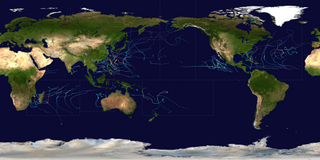
Hurricane Rosa was the only Pacific hurricane to make landfall during the above-average 1994 Pacific hurricane season. It killed at least 4 people in Mexico. Moisture from the hurricane was a factor in widespread flooding in the U.S. state of Texas that killed 22 people and caused hundreds of millions of dollars in damage in October 1994. The pre-Rosa tropical depression formed on October 8 before degenerating the next day. It reformed on October 10 and steadily strengthened as it approached Mexico. Ultimately peaking as a Category 2 hurricane on the Saffir-Simpson Hurricane Scale right before landfall, Rosa was the final hurricane, nineteenth tropical storm, and second-last tropical cyclone of the 1994 Pacific hurricane season.

During 2018, tropical cyclones formed within seven different tropical cyclone basins, located within various parts of the Atlantic, Pacific and Indian Oceans. During the year, a total of 151 tropical cyclones had formed this year to date. 102 tropical cyclones were named by either a Regional Specialized Meteorological Center (RSMC) or a Tropical Cyclone Warning Center (TCWC).

During 2017 tropical cyclones formed within seven different tropical cyclone basins, located within various parts of the Atlantic, Pacific and Indian Oceans. During the year, a total of 146 tropical cyclones had formed. 88 tropical cyclones had been named by either a Regional Specialized Meteorological Center (RSMC) or a Tropical Cyclone Warning Center (TCWC). The strongest and deadliest tropical cyclone was Hurricane Maria with a minimum barometric pressure of 908 mbar and killing 3,000 people in Puerto Rico and Dominica. The costliest tropical cyclone of the year was Hurricane Harvey in the Atlantic, which struck Houston metropolitan area in August causing US$125 billion in damage, tying with Hurricane Katrina as the costliest tropical cyclone worldwide.

During 2019, tropical cyclones formed within seven different tropical cyclone basins, located within various parts of the Atlantic, Pacific and Indian Oceans. During the year,a total of 142 systems formed, with 100 of these developing further and being named by the responsible warning centre. The strongest tropical cyclone of the year was Typhoon Halong, with a minimum barometric pressure of 905 hPa (26.72 inHg). Cyclone Idai became the deadliest tropical cyclone of the year, after killing at least 1,303 people in Mozambique, Malawi, Zimbabwe, and Madagascar. The costliest tropical cyclone of the year was Typhoon Hagibis, which caused more than $15 billion in damage after striking Japan.

During 2012, tropical cyclones formed within seven different tropical cyclone basins, located within various parts of the Atlantic, Pacific and Indian Oceans. During the year, a total of 128 tropical cyclones had formed this year to date. 85 tropical cyclones had been named by either a Regional Specialized Meteorological Center (RSMC) or a Tropical Cyclone Warning Center (TCWC).

Throughout 2013, 139 tropical cyclones formed in seven different areas called basins. Of these, 67 have been named by various weather agencies when they attained maximum sustained winds of 35 knots. The strongest and deadliest tropical cyclone of the year was Typhoon Haiyan, which was estimated to have a minimum barometric pressure of 895 hPa (26.43 inHg) and caused at least 6,300 deaths in the Philippines. The costliest tropical cyclone of the year was Hurricane Manuel, which was responsible for at least $4.2 billion worth of damages in Mexico. 21 major tropical cyclones formed in 2013, including five Category 5 tropical cyclones. The accumulated cyclone energy (ACE) index for the 2013, as calculated by Colorado State University was 618.5 units.

Tropical cyclones regularly affect the coastlines of most of Earth's major bodies of water along the Atlantic, Pacific, and Indian oceans. Also known as hurricanes, typhoons, or other names, tropical cyclones have caused significant destruction and loss of human life, resulting in about 2 million deaths since the 19th century. Powerful cyclones that make landfall – moving from the ocean to over land – are some of the most impactful, although that is not always the case. An average of 86 tropical cyclones of tropical storm intensity form annually worldwide, with 47 reaching hurricane/typhoon strength, and 20 becoming intense tropical cyclones, super typhoons, or major hurricanes.

The following is a list of weather events that occurred in 2021. The year began with La Niña conditions. There were several natural disasters around the world from various types of weather, including blizzards, cold waves, droughts, heat waves, tornadoes, and tropical cyclones. In December, powerful Typhoon Rai moved through the southern Philippines, killing 410 people and becoming the deadliest single weather event of the year. The costliest event of the year, and the costliest natural disaster on record in the United States, was from a North American cold wave in February 2021, which caused $196.4 billion (USD) in damage; the freezing temperatures and widespread power outages in Texas killed hundreds of people. Another significant natural disaster was Hurricane Ida, which struck southeastern Louisiana and later flooded the Northeastern United States, resulting in $70 billion (USD) in damage. December saw two record-breaking tornado outbreaks, only four days apart from each other. In Europe, the European Severe Storms Laboratory documented 1,482 weather-related injuries and 568 weather-related fatalities. The National Oceanic and Atmospheric Administration documented 796 weather-related fatalities and at least 1,327 weather-related injuries in the United States and the territories of the United States.
The following is a list of weather events in 2019.

The following is a list of weather events that occurred in 2018.

The following is a list of weather events that occurred in 2017.

The following is a list of weather events that occurred in 2016.

The following is a list of weather events that occurred on Earth in the year 2014. There were several natural disasters around the world from various types of weather, including blizzards, cold waves, droughts, heat waves, tornadoes, and tropical cyclones. In September, floods in India and Pakistan killed 557 people. The costliest single event was Typhoon Rammasun, which killed 225 people and left over US$8 billion in damage when it moved through the Philippines, China, and Vietnam.

















